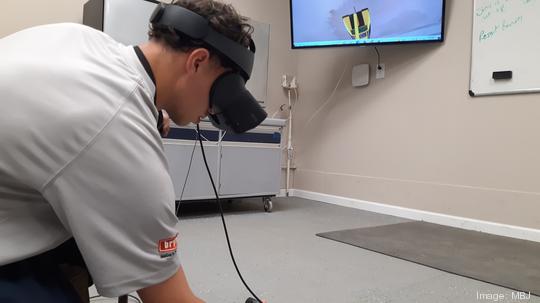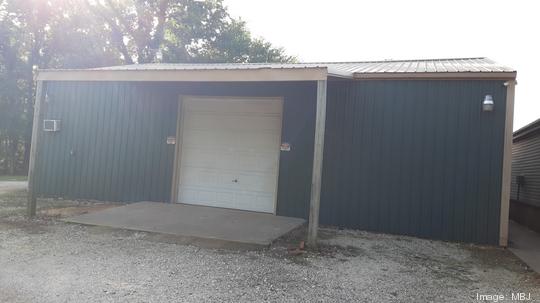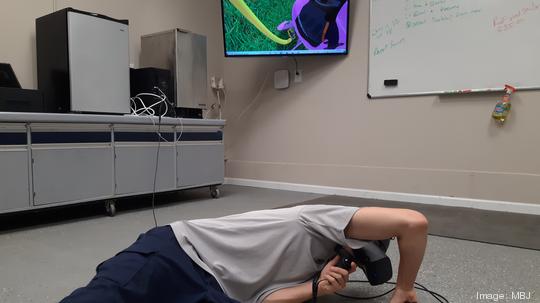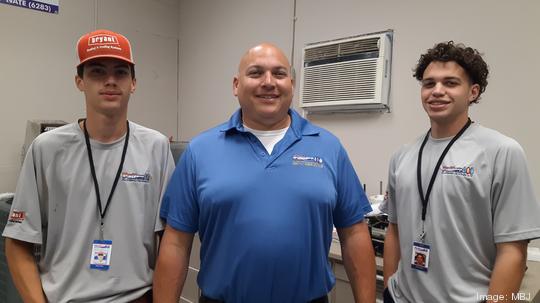
From Colbey Patton’s perspective, he was in the bathroom of a two-story house, trying to fix a leak that was made evident by a puddle of water and a large stain on the lower end of the wall.
But from my perspective, he was kneeling on a concrete floor, with a remote control in each hand and an Oculus virtual reality (VR) headset covering his eyes, though I could see his viewpoint displayed on a TV.
“I wish it wouldn’t have been on the floor again,” Patton said.

This exercise is part of a common practice at the headquarters of Patton Plumbing Heating and AC in Braden, Tennessee. Shawn Patton — the company owner, and Colbey’s father — is using VR to train workers and combat the labor shortage.
Most mornings, employees arrive around 7 a.m., walk past a striped brown and gray cat named Phoebe, sip on coffee, grab a donut, and use the technology to learn new skills or sharpen old ones.
Using the Oculus gear and SkillMill platform — the latter comes from Texas-based software company Interplay Learning — Patton can provide his employees with both coursework done on computers and hundreds of VR-training activities that simulate real-world plumbing and HVAC problems.
They can select an activity then work their way through the entire process, with help from a virtual toolbox and guide — which displays itself on-screen and speaks to them through the headset.
The user is limited to the parameters of the assignment — this isn’t a sandbox format with an entire world to explore. But the technology is still relatively immersive. When you bend in the real world, you bend in the virtual one. When you walk in the real world, you walk in the virtual one.
During an activity where Colbey Patton attempted to fix an outdoor air conditioning unit, he had to lay down to reach the root of the problem. And as I saw him lay down in the training room, I could see on the TV, that he was also laying down digitally.

Shawn Patton started using the technology about a year and a half ago, amid an increasingly challenging labor environment. Finding qualified and available plumbers and HVAC technicians had become difficult, as more high school students were being steered toward four-year colleges and universities. It’s a trend that NPR reported on in 2018, and one that’s led to shortages in the skilled trades.
According to the U.S. Bureau of Labor Statistics, about 51,000 openings for plumbers, pipefitters, and steamfitters are projected each year for the next decade. For heating, air conditioning, and refrigeration mechanics and installers, that number is around 38,500.
And while finding workers wasn’t easy for Patton, luring longtime employees away from other businesses wasn’t likely, either.
“It’s really hard to get seasoned people like me, who are my age or younger, working for established businesses; you’re not pulling those guys away,” Patton said. “Their employers are going to lock them down and not let them go, because they’re too valuable.”
Patton, however, found that he could hire people without experience and train them from the ground up — with the VR platform playing a major role in this.
“We started hiring greener, and younger,” he said. “You’ve got to have something to mix in there with the ride-alongs [with technicians] and daily [training]. Your brain has got to be tested.”

The platform, though, isn’t just used for training new hires. It’s used to hone the skills of seasoned employees, too.
“We test our existing guys, to see if they’re weak anywhere,” he said. “We can reassess, and see what we need to work more on.”
For Patton, it also represents a unique way to learn, one that wasn’t available to him when he was beginning his career.
“The younger crowd likes VR, they like the technology,” he said. “It’s just a different way of learning. I didn’t have anything like this coming up when I was their age, anywhere."









